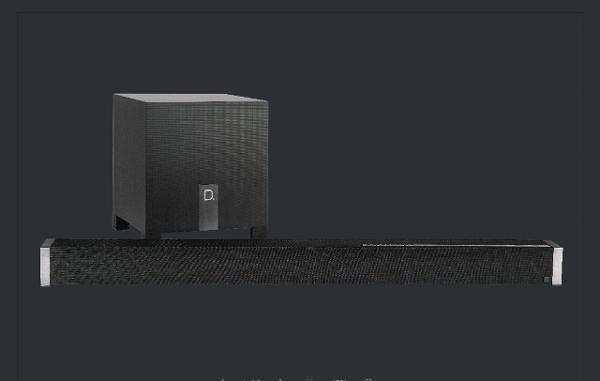Definitive Technology Updates Wi-Fi Soundbars, Shifts From DTS Play-Fi to Chromecast

Def Tech’s $1,299-suggested Studio Advance (pictured) and $899 Studio Slim will be displayed this week at the CEDIA Expo in San Diego and will replace the W Studio and W Studio Micro, which were introduced in late 2014 and late 2015, respectively, at the same prices as their successors. Other features that the new models will add include Bluetooth, an audio mode for night listening, upgraded acoustics and DSP, and enhanced cosmetics.
Though it dropped DTS Play-Fi from the new soundbars, the Sound United-owned brand continues to offer Play-Fi wireless speakers and a Play-Fi amplifier/streamer and will continue to support them. Nonetheless, a spokesman said, “future Definitive sound bars and wireless speakers will move to new platforms such as CCBI and Heos,” which was developed by Sound United brand Denon and is used by both Denon and sister brand Marantz.
“After the acquisition of the D+M Group [former owners of Denon and Marantz] in 2017, Definitive now has access to new platforms and resources such as Heos, so we intend to find opportunities to weave those into upcoming products,” the spokesman told Sound & Vision.
Definitive’s next generation of wireless sound bars “will expand over the next one to two years to include additional sound bars and smart speakers with new features, voice experiences, and proprietary technologies that are currently under development,” he added.
Play-Fi will also eventually be retired from sister brand Polk, which offers Play-Fi speakers and a mix of Play-Fi and CCBI soundbars. Sound United’s Denon and Marantz brands, on the other hand, exclusively support the Denon-developed Heos multiroom platform.
Joel Sietsema, Sound United’s SVP of brand management and marketing, also told Sound & Vision that the company chose to continue with CCBI because of the hundreds of music apps that it supports. Sound United is sticking with its own Heos platform because, unlike DTS’s Play-Fi platform, Sound United controls the technology and its future direction, he added. DTS licensing costs were also a factor, he said.
In the top-end $1,299 Studio Advance, Definitive upgraded three switching HDMI inputs from HDMI 1.4 to HDMI 2.0b to support the passthrough of HDR10 and HLG high dynamic range (HDR) video. The bar also upgrades the HDMI output to include an audio return channel (ARC) to eliminate the need to connect a separate optical-audio cable to the TV to amplify audio from smart-TV apps. The HDMI connection between the TV and sound bar also enables consumers to use their TV’s remote to control basic soundbar functions, Definitive said.
For its part, the Studio Slim lacks HDMI switching inputs but, unlike its predecessor, features an HDMI ARC connection to complement optical and analog audio inputs.
The 5.1-channel Studio Advance features Dolby Digital and DTS 5.1 decoding, nine separately amplified drivers, and dedicated left, center, right and surround channels with DSP to deliver virtual surround. It comes with 8-inch wireless subwoofer. An adjustable center channel lets users increase dialog clarity. Selectable movie, music, and night modes optimize sound for different experiences, with movie mode widening the sound stage and emphasizing dialog and surround effects, while music mode focuses on delivering musical accuracy with focused imaging, the company said. Night mode lets viewers reduce volume without sacrificing dialog clarity and bass.
The Studio Slim is a 3.1-channel sound bar with Dolby Digital and DTS decoding, seven individually amplified drivers, and dedicated left, center, and right channels. It also features an 8-inch wireless subwoofer, adjustable center channel, and movie, music and night modes. Like its predecessor, it is only 1.75-inches-tall to prevent the bar from partially blocking the TV screen or a TV’s IR sensor.
Polk Unveils Entry-Level Soundbars
For its part, sister brand Polk will display its new 2-inch-tall Signa S2 soundbar with wireless subwoofer at $199, replacing the Signa S1 and adding HDMI ARC input. It will be available in October. Features include Dolby Digital 5.1 decoding, Bluetooth, selectable movie/music/night modes, and Polk-patented VoiceAdjust, which improves vocal intelligibility by raising the volume of the center-channel drivers and adding a dash of equalization.
With an HDMI ARC input, the bar adds CEC compatibility so that owners can use the TV remote to change soundbar volume, making the IR learning process unnecessary, a spokesman noted.
With its 5.25-inch powered subwoofer, the Signa S2 outputs a total of 110 watts peak.
In the Signa series, the S2 joins Polk’s lowest priced soundbar, the $129 Signa Solo, which lacks a separate wireless subwoofer but features Dolby Digital decoding, Bluetooth, VoiceAdjust, and proprietary Stereo Dimensional Array (SDA) technology. SDA cancels interaural crosstalk to widen, deepen and heighten the sound stage.
Sound United’s audio brands consist of Denon, Marantz, Polk Audio, Definitive Technology, Polk Boom, Heos, Classe, and Boston Acoustics.













































